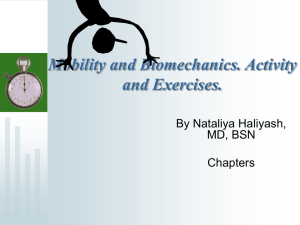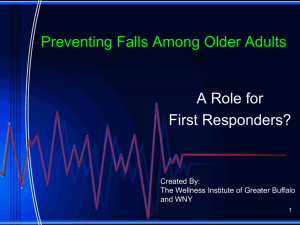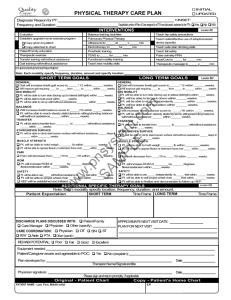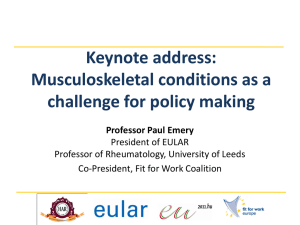Mobility
advertisement
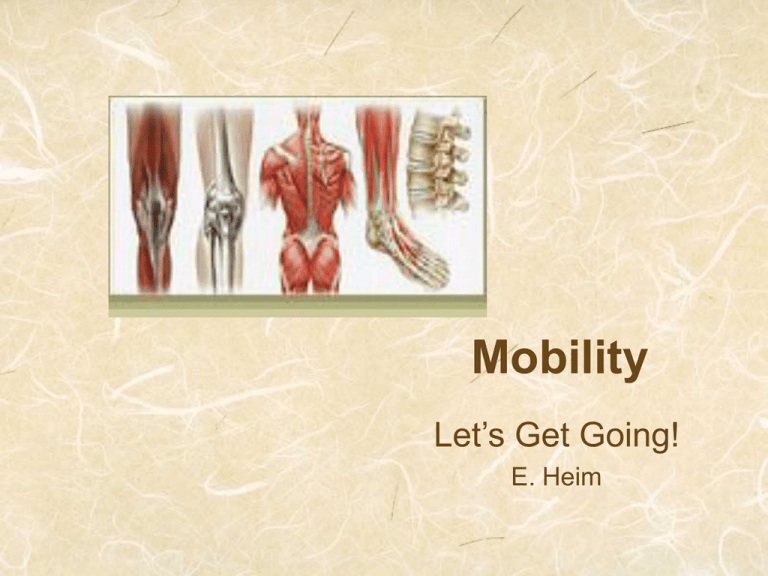
Mobility Let’s Get Going! E. Heim RANC Objectives • • • • • • • Describe the functions of the musculoskeletal and nervous systems in the regulation of movement. Discuss physiological and pathological influences on body alignment and joint mobility. Assess for correct and impaired body alignment and mobility. Discuss the importance of “no-lift” policies for the client and health care provider. Describe equipment needed for safe client handling and movement. Compare and contrast active and passive range-ofmotion exercises. Evaluate the nursing plan for maintaining body alignment and mobility. Scientific Knowledge Base: Nature of Movement Body mechanics Alignment and balance Coordinated efforts of the musculoskeletal and Also refers to posture nervous systems Gravity Friction Weight force exerted on the body Force that occurs in a direction opposite to movement Physiology and Regulation of Movements • Skeletal system – Provides attachments for muscles and ligaments – Provides leverage for movement • Skeletal muscles – Help movement of bones and joints • Nervous system – Regulates movement and posture Muscle Contraction • Mobility requires an interaction of the musculoskeletal & nervous systems • Bones, muscles, & nerves must be healthy • Nerve pathways and spinal nerves must be intact to transmit impulses to the muscle • Chemical reactions occur – Acetylcholine • Electrolytes – Calcium – Sodium – Potassium http://faculty.etsu.edu/forsman/Histologyofmuscleforweb.htm Types of Muscle Contractions • Isotonic – Building bulk or “tone” – Shortening of muscle but no flexion • Isometric – Building strength – Length remains same but force is Pathological Influences on Mobility Postural abnormalities Impaired muscle development Damage to CNS Musculoskeletal trauma Mobility and Immobility • Mobility – The ability to move about freely • Immobility – Inability to move about freely • Bed rest – An intervention that restricts clients for therapeutic reasons • pain • oxygen demand of body • Allows rest periods Systemic Effects Metabolic Respiratory Endocrine, calcium absorption, Atelectasis (“collapsed lung”) and and GI function hypostatic pneumonia Cardiovascular Musculoskeletal Δs Orthostatic hypotension Thrombus (blood clots) Loss of endurance and muscle mass and decreased stability and balance Muscle effects Skeletal effects Loss of muscle mass Muscle atrophy (wasting) Impaired calcium absorption Joint abnormalities Urinary elimination Integumentary Urinary stasis Renal calculi (kidney stones) Pressure ulcer Ischemia (bedsores) Psychosocial Effects • Emotional and behavioral responses – Hostility, giddiness, fear, anxiety • Sensory alterations – Sleep-wake alterations • Changes in coping – Depression, sadness, dejection Developmental Changes Infants, Toddlers, Preschoolers Prolonged immobility delays gross motor skills, intellectual development or musculoskeletal development Adults Physiological systems are at risk for changes in family and social structures Adolescents Delayed in gaining independence and in accomplishing skills Social isolation can occur Older Adults Decreased physical activity Hormonal changes Bone reabsorption Assessment • Mobility – ROM – Gait – Exercise & Activity Tolerance – Body alignment • Standing • Sitting • Lying http://moveintohealth.com/learn_about_restore Assessment • Immobility – Metabolic – Respiratory – Cardiovascular – Musculoskeletal – Integumentary – Elimination – Psychosocial – Developmental Nursing Diagnosis & Planning • Select the applicable NANDA nursing diagnosis: – – – – – Impaired physical mobility Risk for disuse syndrome Risk for injury Impaired skin integrity Social isolation …etc. • The planning phase will establish client goals and outcomes: – Realistic, time-framed, and measurable Implementation Acute Care • Metabolic – Provide high-protein, high-caloric diet with vitamin B and C supplements • Respiratory – Cough & deep breathe every 1 to 2 hours (q1-2h) – Chest physiotherapy (CPT) – Incentive spirometer (IS) • Cardiovascular – Progress from bed to chair to ambulation – SCDs, TED hose, and leg exercises Implementation • Musculoskeletal – Passive ROM • Con’t passive motion (CPM) equipment – Active ROM • Integumentary system http://www.coastalortho.com/articles/acl.htm – Reposition every 1 to 2 hours – Skin care • Elimination system – Adequate hydration – Diet rich in fluids, fruits, vegetables, and fiber Implementation • Positioning techniques – Fowler’s – Supine – Prone – Side lying – Sims • Transfer Evaluation • Gauges the effectiveness of specific interventions designed to promote body alignment, improve mobility, and protect the client from hazards of immobility THE END • Moving on….!


